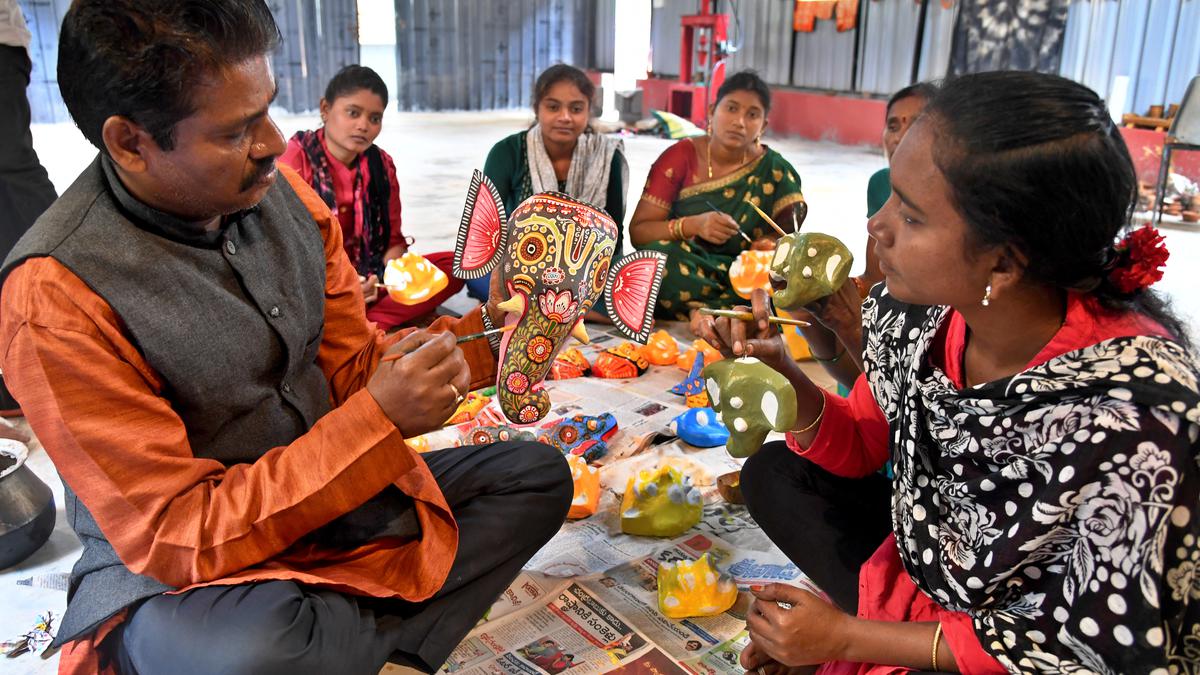
An effort to transform tribal and rural communities through art and craft in Visakhapatnam
The Hindu
Works of art by women from Sambhuvanipalem at the Eastern Ghats Biodiversity Centre provide a glimpse into the rich tapestry of tribal cultures
Women from Sambhuvanipalem village paint in silence as the wintry morning sun slices through trees to fall on their works of art. Dipping the brushes in a coffee concoction, they follow the directions of artist Prathyusha Koduru to make simple patterns and figures of Saura art to compose intricate narratives in light sepia to dark brown. At the end of the day’s session, the women hold out a collection of cloth bags with coffee-tinted Saura paintings, an art practiced by the Saura community — one of the oldest tribes in India residing in the Southern part of Odisha.
The just-concluded workshop at the Eastern Ghats Biodiversity Centre (EGBC) near PM Palem, brought together 10 women from Van Sanrakshan Samiti (VSS) and Eco Development Committee (EDC) of Sambhuvanipalem, who were trained in various art forms by different artists. The initiative was an effort of the Andhra Pradesh Forest Department to train the women in capacity building with an aim to open a workshop and souvenir store within the Eastern Ghats Biodiversity Centre that showcases art and crafts from Andhra Pradesh and Odisha. The products done by the villagers during the workshop are currently on display at the EGBC.
“The 10-day workshop was planned to kick-start the project where we train women from the VSS and EDC in various forms of art works and sell their products at souvenir stores at the EGBC as well as Indira Gandhi Zoological Centre. We are now reaching out to the Van Sanrakshan Samiti of places like Jodugullapalem and Dabbanda to reactivate the accounts of the members through such initiatives of skill development,” says Anant Shankar, Visakhapatnam District Forest Officer, who was instrumental in setting up the Eastern Ghats Biodiversity Centre that opened recently.
During the workshop, the women were trained to make about 20 products involving various art forms which included natural dye art, coffee painting, dokra art, paper mache and bamboo craft. Their works include paper mache masks of elephant, bird and tiger, Saura paintings on tote bags, pottery mugs paired with Araku coffee, Dokra figurines inspired by Andhra tribal women and marine-themed tote bags painted with natural dyes
“The focus of the workshop was on three key areas: reviving indigenous practices, conducting Nature workshops for awareness (wildlife conservation) and empowering women with sustainable livelihoods connected with Nature conservation,” says Tripti Shukla, a Delhi-based independent wildlife researcher, who hosted the workshop and is currently working on the project Vanwasi-Aadiwasi.
“For the past few years, I’ve been capturing the art and craftsmanship of tribal communities, where every creation draws inspiration from Nature. The idea behind the workshop is to also spread awareness about wildlife conservation. For instance, we have conservation postcards done with coffee painting on the pangolin, a shy, solitary, nocturnal creature, believed to be the world’s most trafficked animal,” says Tripti. These crafts are done from readily available materials like coconut shells, natural colors, paper and bamboo.
According to Jameelya Akula who runs the sustainable enterprise Sankalpa Art Village, who also conducted the natural dye workshop for the women, there are many natural dyes that are grown in the forest. “We showed them how to identify natural dye plant species and shared experiences about dyeing cloth with natural colours,” says Jameelya.













